7 Iconic Motorcycle Movie Guns
A lot of people look at motorcycle riders as big, bad, burly dudes on loud machines. News reports of the 1% motorcycle clubs don’t help. Nor does how movies and television often portray motorcycle clubs and riders as either villains and anti-heroes.
This is despite the fact that 99% of motorcycle riders are law-bidding men and women who just enjoy the wind in their faces. They may look tough, but they are good, honest people. Hollywood does the same thing with firearms.
Putting motorcycles and guns together has long been a great way for show business to make huge amounts of money. It has also created some iconic scenes featuring motorcycle movie guns. The American public like seeing motorcycles and guns on the Silver Screen, as well as the small screen. Some of these scenes, along with the guns portrayed will never be forgotten.
Iconic Motorcycle Movie Guns
Winchester 1887

No one knew what to expect when Terminator 2: Judgement Day hit the theaters. We had watched Arnold become an unstoppable bad guy in the first, a movie that also created his catch phrase. We just assumed that he was the antagonist once again.
This is especially true after he walks into a bar and forcibly takes clothes from a pair of tough bikers. As he prepares to ride off on one of their Fat Boys, the bartender confronts the T-800 Model 101 with a sawed-off Winchester 1887. It doesn’t end well for the bartender and Arnold rides away with the lever-action shotgun.
While it was cool watching Arnold flip-cock the 1887, it actually wasn’t the really the best choice of shotguns. This is because the 1887 wasn’t designed for modern smokeless powder. It has also been out of production since 1889. Several companies, however, have produced replicas of this John Moses Browning designed shotgun. Norinco imported a version until sanctions prevented this. The Chiappa 1887 Mare’s Leg is a near replica of the gun used in the movie.
Another movie that featured the Winchester 1887, as well as motorcycles, was Ghost Rider. In that one, Sam Elliot’s character handed Johnny Blaze the lever-action shotgun that the Ghost Rider turned into the Hellfire Shotgun. The Winchester 1887 is probably the pinnacle of cool in motorcycle movie guns.
Magnum Research Inc. Mark VII Desert Eagle

If there was ever a movie that seemed to be a brand marketing gimmick, it was Harley Davidson & the Marlboro Man. Despite the cast being led by representative 80s stars Mickey Rourk and Don Johnson, the movie was considered a flop. It had good acting, but a really bad script.
The movie has, however, become a cult classic. This might be because of the handgun used by Don Johnson’s character, the Marlboro Man, throughout the movie, a Magnum Research Inc. Mark VII Desert Eagle in .44 Magnum. Harley might not have been able to hit water from a boat, but Marlboro was a sharpshooter, even with this monster handgun.
Quite a few models have come out since the Mark VII, but the Desert Eagle still comes in .44, as well as .50 AE, .357 Magnum and even the .429 DE (Desert Eagle). The company now produces the Desert Eagle Mark XIX, with a whole bunch of different finishes. The Magnum Research Desert Eagle is still considered an iconic handgun. The Ruger Super Blackhawk carried by Harley Davidson is no slouch.
Browning M1919A4

While the theme of The Losers was against the Vietnam War, it still showed the rebellious attitudes and outsider status of bikers. It stars William Smith as a former army soldier and leader of The Devil’s Advocates motorcycle club. The U.S. Government recruits this club to rescue an American CIA operative being held by the Viet Cong in Cambodia.
To accomplish this mission, the club modify their motorcycles into war machines, with armor and firearms, including one with a pair of Browning M1919A4 machine guns. The group even added a rocket launcher between the M1919A4s.
The Browning M1919A4 is an air-cooled machine gun that saw heavy use in WWI and WWII. It is still used today by some militaries, but has mostly been pushed into secondary roles by more general-purpose machine guns, such as the M60.
The M1919A4 came in a variety of chamberings, but the main U.S. models started in .30-06 Sprg., the main military cartridge at the time, and 7.62×51, another popular military round. There are still both semi-auto and full-auto versions of this piece of history, available to the public. Prices vary greatly on condition, provenance and capabilities.
Smith & Wesson Model 39
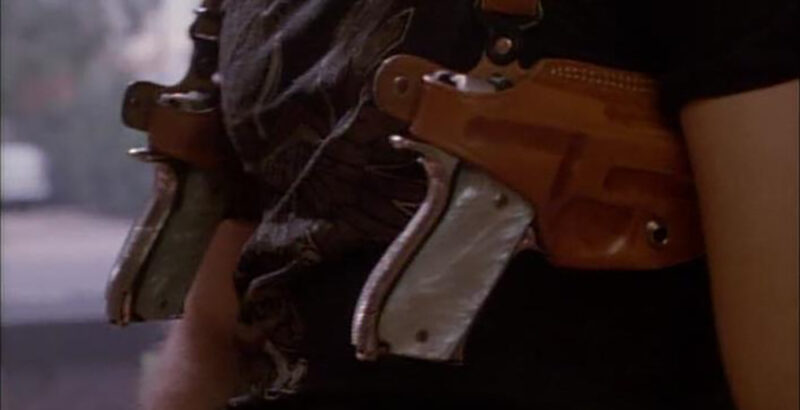
Charlie Sheen isn’t the first to come to mind when thinking bikers, but once he grew his hair and let the beard grow, he came off pretty well as undercover police officer Daniel “Dan” Saxon in Beyond the Law. This movie had all the stereotypes, from outlaw image of bikers to their long-standing problem with cowboys. It even has torn identity, as Sid struggles with his morality throughout the film.
There is nothing immoral about the pair of Smith & Wesson 39s carried by Sheen’s character in the film. These 9mm semi-auto pistols come stainless with pearl handles. He carries them in a Galco dual-pistol shoulder rig that looks almost as good as the guns.
Developed to replace the M1911, the S&W 39 was one of the company’s first semi-auto pistols, as well as one of the first DA pistols made in the U.S. When this 8-round capacity, 9mm pistol lost out, S&W introduced it to the civilian market; a modified version saw some use in the U.S. Navy during Vietnam. The company produced this pistol from 1954 to 1983, showing it was a pretty good design.
Calico M950
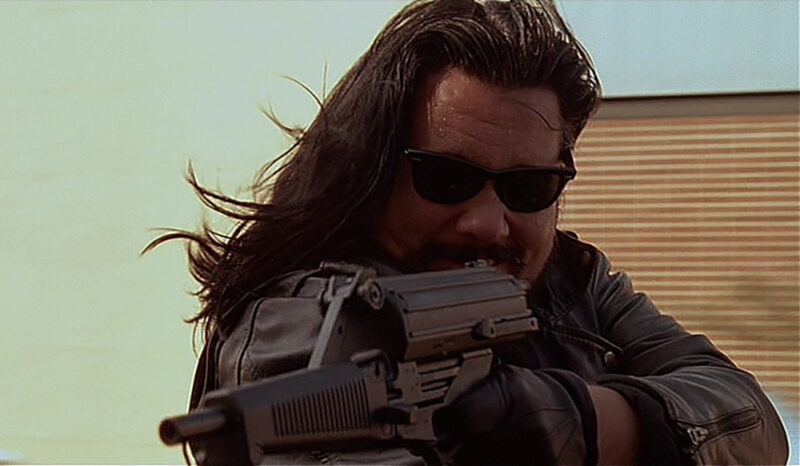
After injuries ended his NFL career, Brian Bosworth moved into acting, making his debut in Stone Cold. In it, he plays a cop who goes undercover with a motorcycle gang. His acting was panned and it didn’t do very well at the box office. This is despite some supporting roles going to some pretty decent actors, one of which, William Forsythe, carried a Calico M950 in the movie.
The Calico M950 is a semi-auto 9mm pistol introduced in the 80s. It was also available in full auto to military and law enforcement. It’s distinct design has actually made it quite popular in movies, particularly futuristic movies. This gun also appeared in RoboCop 2, Total Recall and Tomorrow Never Dies, among others.
The Calico M950 uses a roller-delayed blowback system, similar to that used in the Heckler & Koch MP5. It also has a top-mounted helical magazine that holds either 50 or 100 rounds. The weight on top helps manage recoil. However, the magazine must be carefully loaded and it has unusual ergonomics.
Smith & Wesson Model 29
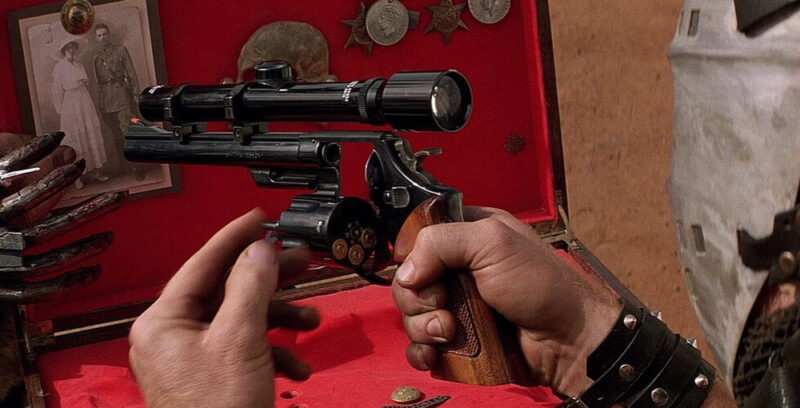
Max didn’t ride a motorcycle in The Road Warrior, nor did Lord Humungus, but this apocalyptic masterpiece featured quite a few of them. It also featured a beautiful Smith & Wesson Model 29 with a scope. And It showed how ammunition will get scarce in a world gone mad situation.
Mel Gibson’s character constantly looked for shells to go in his cut-down Stoeger Longfowler shotgun. Lord Humungus kept his few rounds in the same case as his prized revolver. Most of his marauders used crossbows, some of which were attached to their arms.
Smith & Wesson introduced the Model 29 in 1955. It quickly became popular with shooters. It really jumped to the forefront when Clint Eastwood carried one in Dirty Harry. This double-action revolver came chambered in the most powerful production handgun round at the time. It also came in a variety of barrel lengths, and went through several production changes over the years. It is still one of the most popular big-bore revolvers available.
Rossi Overland
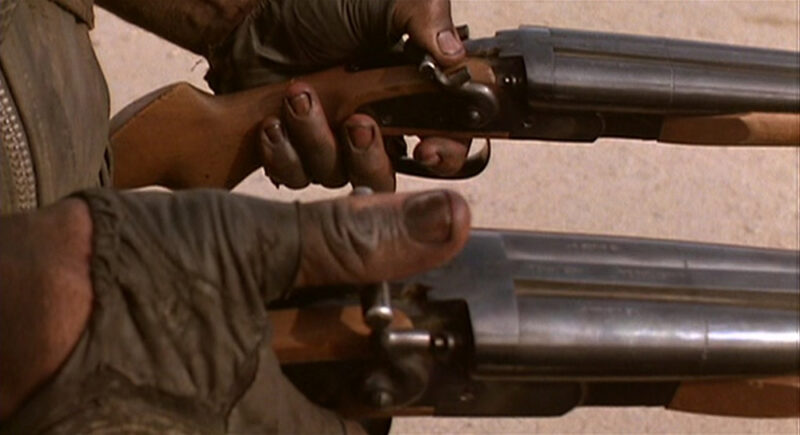
While it was a little weird, Raising Arizona was considered a financial success. This is despite it only grossing $29 million, which is not considered much at the box office; they made it on a budget of $6 million. Like a lot of other movies that feature motorcycle movie guns, this Coen brothers film became a cult classic.
The motorcycle movie guns featured are a pair of altered Rossi Overland double-barrel shotguns carried by Randle “Tex” Cobb, who plays biker bounty hunter Leonard Smalls. The Lone Biker of the Apocalypse doesn’t say much in the film, but his looks, demeanor and arms show the menacing nature and point of his character.
The Rossi Overland is a side-by-side double barrel with exposed hammers. As such, most would consider it a coach gun, despite being introduced in the late 70s. Rossi ended production in 1994, but it is still popular with historical shooters. Shooters liked this classic “Old West” style shotgun because it was durable and affordable.
By Paul Rackley, GunBroker Editor
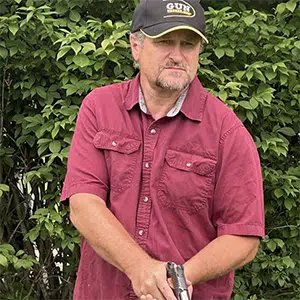
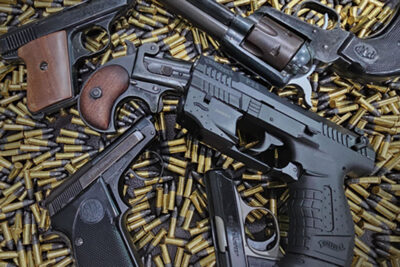
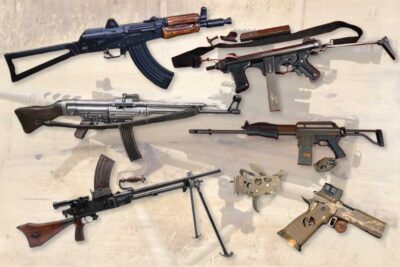

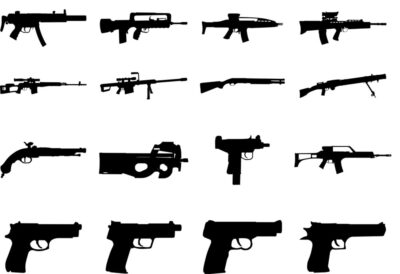
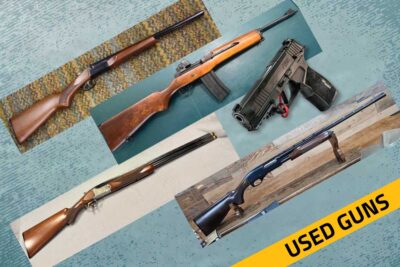

![SHOT Show 2025 Day 2 with GunBroker [Video]](https://qacontent.gunbroker.com/wp-content/uploads/2025/01/SHOT-Show-2025-Day-2-Featured-400x267.png)
![SHOT Show 2025 Day 3 with GunBroker [Video]](https://qacontent.gunbroker.com/wp-content/uploads/2025/01/SHOT-Day-3-400x267.png)
![Features of Smith & Wesson Model 1854 Stealth Hunter – A Lever Action in Multiple Calibers [Video]](https://qacontent.gunbroker.com/wp-content/uploads/2025/02/Smith-Wesson-Model-1854-Stealth-Hunter_lever-action-400x267.jpg)
![Smith & Wesson SPEC Series V M&P® 9 METAL HD [Video]](https://qacontent.gunbroker.com/wp-content/uploads/2025/02/SW-SPEC-Series-V-MP-9-METAL-HD-featured-gunbroker-400x267.jpg)
![Highlights of the Browning Citori 825 Pro Sporting Over & Under Shotgun [Video]](https://qacontent.gunbroker.com/wp-content/uploads/2025/02/Browning_Citori_825_pro_sporting-featured-400x267.jpg)